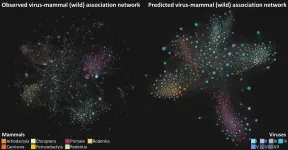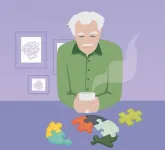AI used to predict unknown links between viruses and mammals
2021-06-25
(Press-News.org) A new University of Liverpool study could help scientists mitigate the future spread of zoonotic and livestock diseases caused by existing viruses.
Researchers have used a form or artificial intelligence (AI) called machine-learning to predict more than 20,000 unknown associations between known viruses and susceptible mammalian species. The findings, which are published in Nature Communications, could be used to help target disease surveillance programmes.
Thousands of viruses are known to affect mammals, with recent estimates indicating that less than 1% of mammalian viral diversity has been discovered to date. Some of these viruses such as human and feline immunodeficiency viruses have a very narrow host range, whereas others such as rabies and West Nile viruses have very wide host ranges.
"Host range is an important predictor of whether a virus is zoonotic and therefore poses a risk to humans. Most recently, SARS-CoV-2 has been found to have a relatively broad host range which may have facilitated its spill-over to humans. However, our knowledge of the host range of most viruses remains limited," explains lead researcher Dr Maya Wardeh from the University's Institute of Infection, Veterinary and Ecological Sciences.
To address this knowledge gap, the researchers developed a novel machine learning framework to predict unknown associations between known viruses and susceptible mammalian species by consolidating three distinct perspectives - that of each virus, each mammal, and the network connecting them, respectively.
Their results suggests that there are more than five times as many associations between known zoonotic viruses and wild and semi-domesticated mammals than previously thought. In particular, bats and rodents, which have been associated with recent outbreaks of emerging viruses such as coronaviruses and hantaviruses, were linked with increased risk of zoonotic viruses.
The model also predicts a five-fold increase in associations between wild and semi-domesticated mammals and viruses of economically important domestic species such as livestock and pets.
Dr Wardeh said: "As viruses continue to move across the globe, our model provides a powerful way to assess potential hosts they have yet to encounter. Having this foresight could help to identify and mitigate zoonotic and animal-disease risks, such as spill-over from animal reservoirs into human populations."
Dr Wardeh is currently expanding the approach to predict the ability of ticks and insects to transmit viruses to birds and mammals, which will enable prioritisation of laboratory-based vector-competence studies worldwide to help mitigate future outbreaks of vector-borne diseases.
INFORMATION:
[Attachments] See images for this press release:

ELSE PRESS RELEASES FROM THIS DATE:
2021-06-25
Canadian researchers at The Ottawa Hospital, the University of Ottawa, the Bruyère Research Institute and ICES have built and validated an online calculator that empowers individuals 55 and over to better understand the health of their brain and how they can reduce their risk of being diagnosed with dementia in the next five years.
Their process was published today in the Journal of Epidemiology and Community Health, and the calculator is available at projectbiglife.ca.
Dementia is an umbrella term for loss of memory and other thinking abilities severe enough to interfere with daily life. Every year, 76,000 new cases of dementia are diagnosed ...
2021-06-25
Multisystem Inflammatory Syndrome in Children (MIS-C) significantly affected more Black and Latino children than white children, with Black children at the highest risk, according to a new observational study of 124 pediatric patients treated at Children's National Hospital in Washington, D.C. Researchers also found cardiac complications, including systolic myocardial dysfunction and valvular regurgitation, were more common in MIS-C patients who were critically ill. Of the 124 patients, 63 were ultimately diagnosed with MIS-C and were compared with 61 patients deemed controls who presented with similar symptoms but ultimately had an alternative diagnosis.
In the study, published ...
2021-06-25
Burnout is a widespread reality in today's NHS
Current NHS workforce plans are "a smart looking car minus the engine"
An editorial published by The BMJ today raises important concerns about the health
and wellbeing of the NHS workforce after a parliamentary report found "burnout is a widespread reality in today's NHS."
Commenting on the report, Suzie Bailey of the King's Fund says: "Excessive workloads need to be dealt with at every level of the health and care system."
She suggests that ineffective workforce planning is partly to blame, citing evidence ...
2021-06-25
New research has discovered that common artificial sweeteners can cause previously healthy gut bacteria to become diseased and invade the gut wall, potentially leading to serious health issues.
The study, published in the International Journal of Molecular Sciences, is the first to show the pathogenic effects of some of the most widely used artificial sweeteners - saccharin, sucralose, and aspartame - on two types of gut bacteria, E. coli (Escherichia coli) and E. faecalis (Enterococcus faecalis).
Previous studies have shown that artificial sweeteners can change the number and type of bacteria in the gut, but this new molecular research, led by academics from Anglia Ruskin University (ARU), has demonstrated that sweeteners can also make ...
2021-06-25
A growing trove of data to help scientists understand the biology of Alzheimer's disease among diverse populations within the context of sociocultural, behavioral and environmental factors is now available through the Institute for Translational Research at The University of North Texas Health Science Center at Fort Worth (HSC).
The research data is the result of the Health and Aging Brain among Latino Elders (HABLE) study launched in 2017 with $12 million in funding from the National Institutes of Health and headed by Sid O'Bryant, PhD, Executive Director of the Institute.
In 2020, the HABLE study received an additional $45 million from ...
2021-06-25
Over the last decade, severe outbreaks of bacterial canker have caused huge economic losses for kiwi growers, especially in Italy, New Zealand, and China, which are among the largest producers. Bacterial canker is caused by the bacterial pathogen Pseudomonas syringae pv. actinidiae (Psa) and more recent outbreaks have been particularly devastating due to the emergence of a new, extremely aggressive biovar called Psa3.
Due to its recent introduction, the molecular basis of Psa3's virulence is unknown, making it difficult to develop mitigation strategies. In light of this dilemma, a group of scientists at the University of Verona and University of Rome collaborated on ...
2021-06-24
In children with rhabdomyosarcoma, or RMS, a rare cancer that affects the muscles and other soft tissues, the presence of mutations in several genes, including TP53, MYOD1, and CDKN2A, appear to be associated with a more aggressive form of the disease and a poorer chance of survival. This finding is from the largest-ever international study on RMS, led by scientists at the National Cancer Institute's (NCI) Center for Cancer Research, part of the National Institutes of Health.
The study, published in the Journal of Clinical Oncology on June 24, provides an unprecedented look at data for a large cohort of patients with RMS, offering genetic clues that could lead to more widespread use of tumor genetic ...
2021-06-24
A new study could lead to improved decision making in assigning treatments for children with the aggressive cancer rhabdomyosarcoma after revealing key genetic changes underlying development of the disease.
In the largest and most comprehensive study of rhabdomyosarcoma to date, scientists found that specific genetic changes in tumours are linked to aggressiveness, early age of onset and location in the body.
All these factors affect the chances that children will survive their disease - and understanding how they are driven by a cancer's genetics could lead to new ways of tailoring treatment for each patient.
Rhabdomyosarcoma is a rare type of cancer that resembles muscle tissue and mostly affects ...
2021-06-24
Ozone levels in the earth's troposphere (the lowest level of our atmosphere) can now be forecasted with accuracy up to two weeks in advance, a remarkable improvement over current systems that can accurately predict ozone levels only three days ahead. The new artificial intelligence system developed in the University of Houston's Air Quality Forecasting and Modeling Lab could lead to improved ways to control high ozone problems and even contribute to solutions for climate change issues.
"This was very challenging. Nobody had done this previously. I believe we are the first to try to forecast surface ...
2021-06-24
ITHACA, N.Y. - Tossing worn-out solar panels into landfills may soon become electronics waste history.
Designing a recycling strategy for a new, forthcoming generation of photovoltaic solar cells - made from metal halide perovskites, a family of crystalline materials with structures like the natural mineral calcium titanate - will add a stronger dose of environmental friendliness to a green industry, according to Cornell University-led research published June 24 in Nature Sustainability.
The paper shows substantial benefits to recycling perovskite solar panels, though ...
LAST 30 PRESS RELEASES:
[Press-News.org] AI used to predict unknown links between viruses and mammals





